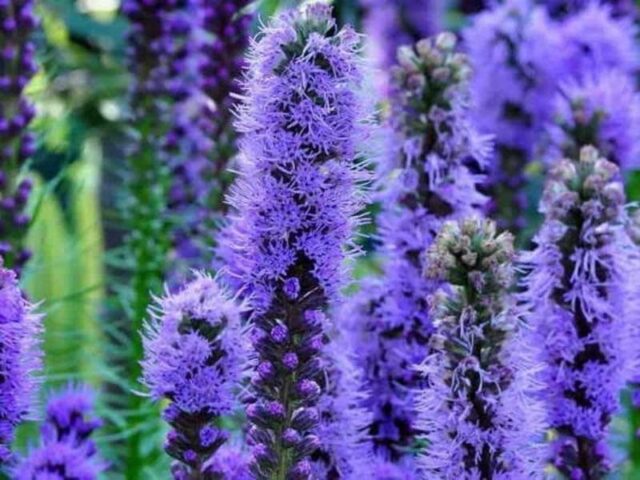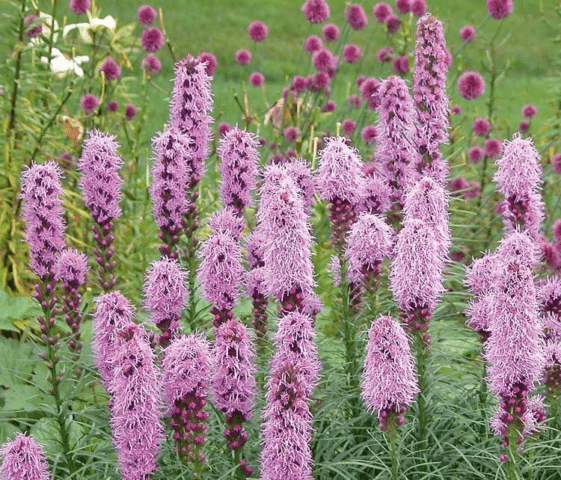Content
- 1 Photo and description of Liatris
- 2 Liatris varieties with photos and names
- 3 When does Liatris bloom?
- 4 When to plant liatris
- 5 Planting liatris with tubers
- 6 How to care for liatris
- 7 When to replant liatris
- 8 How does Liatris reproduce?
- 9 Diseases and pests of liatris
- 10 Photo of liatris in garden landscape design
- 11 Conclusion
- 12 Reviews about Liatris
Liatris (lat. Liatris) is a genus of perennial flowering plants of the Asteraceae family. In nature, the culture is found in North America, Mexico, and the Bahamas. Valued for its unpretentiousness and decorative qualities. Cultivated since the beginning of the 18th century. Many gardeners prefer to grow this perennial in their garden plots, as its candle-shaped inflorescences not only look impressive, but also exude a pleasant aroma that combines the smell of fresh hay and vanilla. However, for the successful development of the plant, planting and caring for liatris in open ground must meet the requirements of the culture. Only under these conditions will the perennial be able to delight with lush flowering every year.

Folk names for liatris are deer tongue, funny feathers
Photo and description of Liatris
A perennial is a herbaceous plant with upright growing simple or branched shoots. Its height reaches 30-100 cm during the flowering period. Liatris stems are densely covered with whorled or linear leaves with a pointed tip. The plates have a rich green hue that lasts throughout the season. Therefore, liatris can become a background for other garden crops after flowering.
The underground part of the plant is represented by tuberous roots, similar to bulbs, which are interconnected by thin processes. They are found in the top layer of soil.
Liatris flowers are miniature, they are collected in small baskets, which are located close to each other and form a spike-shaped lush apical inflorescence. Its length is 30-50 cm. The shade of the buds varies from rich violet or purple to light pink, cream and even white. The fruits of Liatris are an oblong achene covered with hairs.
Liatris varieties with photos and names
Several varieties of liatris are widely used in gardening. All of them are the basis for the development of new varieties of crops, which are characterized by high decorativeness, a variety of shades and ease of cultivation. To be able to distinguish between the main types of culture, you need to study the features of the most popular of them.
Spicate
This species is native to southeastern North America. The height of the plant reaches 50 cm. Liatris spicata has been cultivated since 1732. The length of its inflorescences is 35 cm. The flowering period of this liatris lasts for 1.5 months. Winters well in central Russia.
Popular varieties:
- Alba - 50-80 cm high, with snow-white flowers.
Alba can be combined with any other crop variety
- Blue bird - height 50 cm, blue inflorescences.
Bluebird blooms for two months
- Kobold - height no more than 40 cm, the color of the inflorescences is soft violet.
The Kobold variety is great for the foreground of compositions
Filmy
A distinctive feature of the species is the wide leaves and larger inflorescences of the basket. Therefore, filmy liatris (Liatris scariosa) looks organically in any landscape, as can be seen in the photo. The most common varieties include September Glory. The color of its buds is soft pink. The height of liatris during flowering reaches 1 m. And the length of its inflorescences is 50-60 cm.

Liatris membranous September Glory is characterized by abundant flowering
Rough
This species is considered the tallest because it can reach 2 m. The erect stems of Liatris aspera are densely covered with small leaves. Triangular or rounded inflorescences are formed in the upper part of the shoots.
The most common variety of this type of crop is White Spire. Its distinctive feature is the snow-white shade of the flowers. The height of this varietal liatris reaches 70 cm.

Liatris White Spire has high endurance
When does Liatris bloom?
The plant forms flower stalks in mid-to-late June and continues for 6-8 weeks. This is due to the gradual opening of the buds from top to bottom, and not vice versa, as in other garden crops with similar inflorescences. Depending on weather conditions, the flowering time of liatris may shift slightly, and the duration of this period may also change.
When to plant liatris
The perennial can be planted in a permanent place in spring or autumn. In the case of the first option, the optimal period is April. But at the same time it is also necessary to focus on weather conditions. For rapid rooting of liatris, it is necessary that the soil warms up to a depth of 7-10 cm, and the air temperature is not lower than +8 ° C.
If planting is carried out in the fall, then the best time for this is September. In this case, the perennial will have time to take root before winter.
Planting liatris with tubers
It is necessary to plant a perennial taking into account its basic requirements. This guarantees that it will not only be able to fully develop, but also bloom profusely for many years.
Place for planting liatris
Open and slightly shaded areas are suitable for this herbaceous perennial. The main thing is that the plant is illuminated for at least 12 hours a day. Liatris easily withstands direct sunlight and elevated air temperatures. Therefore, even during the July heat, the plant remains decorative.
This plant prefers loose, nutritious soil with a neutral acidity level. The best option for liatris is sandy loam soil with the addition of humus at the rate of 10 kg per square meter. m. You can also grow perennials in loamy soil if you first add not only organic matter, but also sand 5 kg per square meter. m.
Landing rules
Perennial tubers must be planted in holes 3-10 cm deep, depending on their size. A distance of 15-20 cm must be maintained between plants so that they can fully develop and not compete for food and moisture. When planting on the bottom, you need to pour a thin layer of sand down, on which to place the tuber and sprinkle with earth. At the end of the procedure, water the area generously by sprinkling and cover with a layer of agrofibre.

Planting depth should be equal to the height of the tuber multiplied by two
How to care for liatris
Liatris does not require complex care, so even a novice gardener can cope with its cultivation. But in order for the plant to bloom profusely every year and have a presentable appearance, it is necessary to follow certain rules of agricultural technology.
Watering
Perennials need to be watered only when there is a long absence of seasonal rainfall. To do this, you can use settled water at a temperature of +18-22 °C. Moisturize in the evening. The regularity of watering directly depends on the air temperature. During hot periods it should be carried out 1-2 times every three days, and the rest of the time - once a week.
To prevent excessive evaporation of moisture from the soil, it is recommended to lay a 2-3 cm layer of humus mulch at the base of the liatris.

Perennial does not respond well to excessive soil moisture
Top dressing
Liatris responds well to fertilizing with mineral fertilizers. Therefore, it is recommended to fertilize the plant three times per season. The first time you need to fertilize is in the spring, during the active growth of shoots and foliage. During this period, you can use urea or ammonium nitrate at the rate of 30 g per 10 liters of water.
The second and third feedings are recommended before and after flowering.They should be carried out using 40 g of superphosphate and potassium sulphide per bucket of water. Pour 1 liter of nutrient solution onto each plant.
When and how to prune liatris
It is recommended to prune liatris for the first time after flowering. At this time, only faded flower stalks need to be cut off. The leaves of the plant cannot be removed at this stage, as they feed the root system of the perennial. You can completely cut off the above-ground part of the plant after it turns sharply yellow. In this case, the length of the shoots should be reduced to 10-15 cm.
Also, as it grows during the season, liatris needs sanitary pruning. It involves removing damaged shoots that may break due to strong gusts of wind.
Is it necessary to dig up liatris for the winter?
The level of winter hardiness of liatris allows it to be grown in the southern and central regions of the country, leaving the plant in the ground during the cold season. And in the northern regions of the country, plant roots need to be dug up in September and stored in a cool, dry place until spring, sprinkled with wet peat.
Preparing Liatris for Winter
In late autumn, at the stage of preparation for winter, the shoots of the plant need to be shortened to a length of 10-15 cm. And after this, it is recommended to insulate the root system of the liatris with a layer of mulch 10 cm thick. For this, you can use humus or peat.
When to replant liatris
Sometimes there is a need to transplant the liatris. In this case, the plant needs to be dug up from all sides and the root system carefully removed from the ground. After this, it must be transferred to a new area and watered abundantly. Liatris can be transplanted to another location in autumn or early spring.

The perennial blooms when planted with tubers already in the current season
How does Liatris reproduce?
To obtain new perennial seedlings, you can use seeds, as well as cuttings of bushes and tubers. Each of these reproduction methods has its own characteristics, which you need to familiarize yourself with in advance.
Planting liatris with seeds
To grow liatris from seeds, you can plant directly in open ground before winter or early spring. To do this, you need to dig up the area, carefully remove the roots of the weeds, and also add humus at the rate of 10 kg per 1 sq. m. m. After this, level the soil surface and make furrows 1-1.5 cm deep.
Before planting, seeds should be kept for 24 hours in a humate solution. Then they need to be slightly dried until they become free-flowing, planted in furrows and sprinkled with earth. After this, the area must be watered abundantly.
You can also grow liatris from seeds at home. But in this case, stratification of planting material will be required for two months. To do this, you need to sow in wide containers filled with nutrient soil, and then put them in the refrigerator. After the waiting period has expired, transfer the containers to a bright windowsill and, when seedlings appear, provide standard care. When the seedlings grow two true leaves, they need to be planted in separate cups. When propagated by seeds, liatris does not retain varietal properties.
Dividing the bush
This is the easiest way to propagate liatris. To do this, you need to dig up the bush from all sides and carefully remove the perennial root system from the ground.Then you need to divide it into several parts, each of which should have a root collar with tubers. After this, they need to be immediately moved to a new place and watered abundantly.

You can divide the bush no more than once every 4-5 years
Tuber division
This propagation method, unlike the previous one, can be used annually without harming the plant. To do this, at the end of August you need to make a depression near the root system of the liatris and separate one tuber from the mother plant. It needs to be planted with the recess down and watered well. The next year, several more tubers will form near the division, and thus a new bush will form.
Diseases and pests of liatris
This perennial is characterized by high resistance to diseases. However, stagnation of moisture in the soil and excessive watering can cause root rot. Therefore, if the shoots suddenly wilt, it is necessary to immediately dig up the plant, remove the affected tubers, replant it in a new place and water it with Previkur Energy.
Among the pests, slugs that feed on its leaves and peduncles can cause damage to the plant. In this case, the base of the bushes should be thickly sprinkled with wood ash or tobacco dust. And in case of mass spread of pests, use chemical granular products based on metaldehyde.
Photo of liatris in garden landscape design
Liatris is widely used as an element of landscape design. After all, it can look spectacular in mono plantings, and also successfully complement any composition. In the photo you can see how liatris look in the country, in the garden and in combination with other crops.

Perennial can become the main crop in the flowerbed

Different types of crops look great when planted close together

Liatris goes well with bright annuals
Conclusion
Planting and caring for liatris in open ground does not require complex actions. It is enough to adhere to the standard rules, then this perennial will quickly adapt to a new place, grow, and delight with abundant flowering every year. Therefore, every year it becomes more and more popular not only among professional, but also among novice gardeners.
Reviews about Liatris











